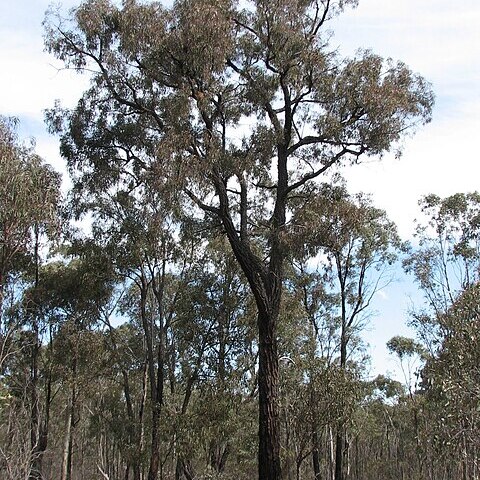Tree to 35 m tall. Forming a lignotuber. Ironbark to small branches, dark grey to black, deeply furrowed, thick and hard. Juvenile growth (coppice or field seedlings to 50 cm): stem rounded in cross-section; juvenile leaves always petiolate, opposite for 5 to 7 nodes then alternate, elliptical to lanceolate, 4–11 cm long, 1.3–3 cm wide, base tapering to petiole, green to grey-green. Adult leaves alternate, petiole 1–3 cm long; blade lanceolate to falcate, 8–22 cm long, 1–2.6 cm wide, base tapering to petiole, concolorous, glossy or dull, green to grey-green or glaucous, side veins acute, densely reticulate, intramarginal vein parallel to and remote from margin (sometimes double), oil glands mostly intersectional. Inflorescence axillary unbranched, peduncle often pendulous, 0.5–1.8 cm long, buds 3 per umbel or on some plants mixed with umbels of 7, pedicels 0.5–1.8 cm long. Mature buds ovoid, 1–1.5 cm long, 0.6–0.9 cm wide, green to creamy (flushed with pink), scar absent, operculum conical to beaked, stamens inflexed, with outer staminodes, anthers adnate, positioned obliquely at filament tip, cuboid, dehiscing by terminal pores, style long, stigma pin-head shaped, locules 4 to 7, the placentae each with 4 vertical ovule rows. Flowers white or pale pink. Fruit on pedicels 0.5–2 cm long, cylindrical to truncate-globose, 0.8–1.3 cm long, 0.8–1.5 cm wide, disc descending, staminophore broad and deciduous, valves 4 to 7, enclosed. Seeds brown or grey, 1–2 mm long, ovoid or flattened-ovoid, often pointed at one end, sometimes lacunose, dorsal surface shallowly pitted, hilum ventral. Cultivated seedlings (measured at ca node 10): cotyledons reniform to oblong; stems square to rounded in cross-section; leaves petiolate, opposite for 6 or 7 pairs, lanceolate, 4–11 cm long, 0.7–4 cm wide, base tapering, margin entire, apex rounded to pointed, concolorous, grey-green to green.
More
Juvenile leaves lanceolate to ovate. Adult leaves: lamina 9.5–22 cm long, 1–2 cm wide, green. Umbels 3-flowered; peduncle 5–18 mm long; pedicels 7–18 mm long. Operculum 2–5 mm long, 4–6 mm wide; hypanthium 4–5 mm long, 4–6 mm wide. Fruits ovoid, hemispherical or subglobular, 9–14 mm long and wide; valves 5 or 6.


